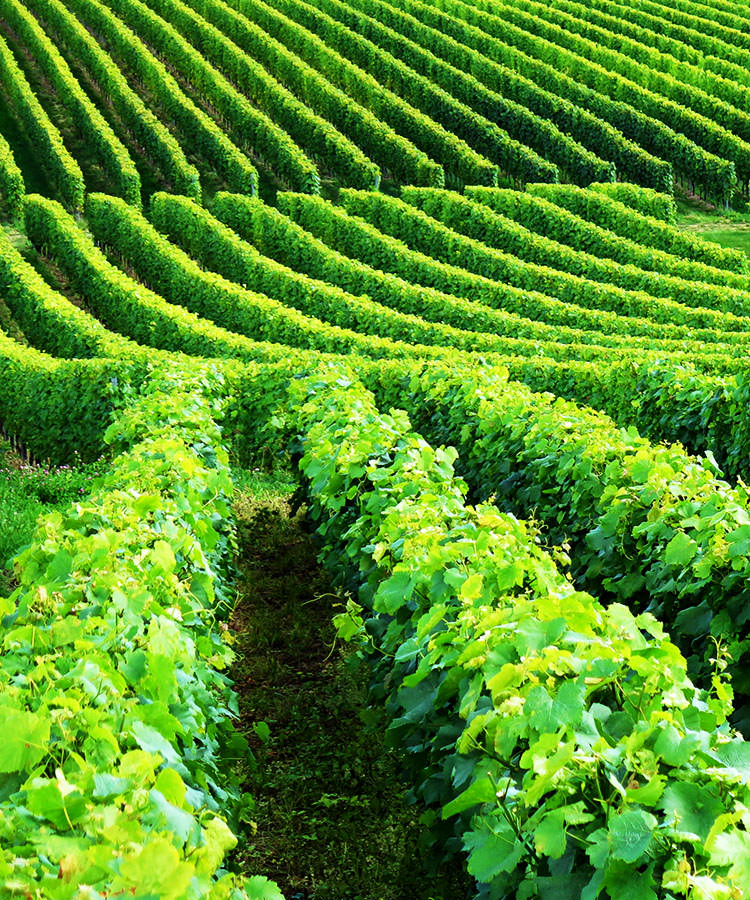When it comes to people, “healthy” doesn’t come in a single shape, size, or color. The same is true for vineyards. From burly Zinfandel vines that look more like trees to slender-trunked Riesling vineyards in Germany, healthy vineyards come in many forms, and they aren’t always postcard-perfect landscapes. In fact, the most attractive vineyard could be the unhealthiest.
That doesn’t mean it takes a doctor or scientist to tell if a hillside is healthy. With a slightly discerning eye, any wine lover can see if a vineyard is thriving or struggling. Here are some ways to tell how healthy a vineyard is.
Look Down
Look at the ground. Is there perfectly manicured grass between the rows? Is the ground by the vine roots bare? This neat landscape protocol might look nice, but it’s the first indicator of traditional (read: pesticide-heavy) farming in action.
Many vineyards use Roundup or other common weed killers around the vine base to stomp out weeds that compete with the vine. The practice is common but it means the vineyard is absolutely not organically farmed. Kathleen Inman, who owns a certified sustainable vineyard in Sonoma’s Russian River Valley, says that mindset is outdated.
“A messy vineyard looks like you’re not taking care,” she explains, “But people don’t realize that’s an organic vineyard and weeds under the vines doesn’t necessarily affect the quality of the fruit at all.“
On the flip side, some vineyards will look wild between the rows, with some mix of grassy plants. Those mixed plants are called a cover crop and they’re designed to restore soil vitality and encourage biodiversity in the vineyard. A vineyard where you see that crop is one where the environment is being looked after, whether it’s certified organic or not.
Look Around
The soil under your feet gives clues about the vines, but a broad view shows how the entire ecosystem is being managed.
Inman suggests looking around for plants other than vines for a hint about how the farming regimen works. “At my vineyard, I don’t mow or really till,” she said. “We have a sow of all sorts of wildflowers that attract beneficial insects and that’s a nice, healthy ecosystem.”
Those plants could come in the form of a traditional garden or ornate landscaping, or they could simply be growing wild around fences or the edges of vineyard roads, but visible diversity is a friend nevertheless.
An array of plants attracts bees, earthworms, butterflies, and birds, all of which contribute to pollination (and there’s no wine without pollinated vines) and good biodiversity. The presence of some animals also provides a natural method for pest control that doesn’t leach pesticides into the soil, and eventually into the grapes we drink.
“I like to see perches for hawks and other birds of prey [like] owl boxes,” says Inman. “That shows you’re looking for natural methods to control pests like gophers, instead of relying on poisons.”
Zoom In
Skip the magnifying glass, but take a good look at the leaves on a grapevine for a final clue on how they’re doing. Healthy grape leaves are dark green and broad, about the size of an outstretched hand, and they should be smooth.
Discoloration, dry leaves, or holes all indicate that something is going wrong in the vineyard. For example, leaves with lighter green spots likely don’t have the right nutrients, or have too much of a natural element like boron or nitrogen. Holes in the leaves themselves or jagged edges indicate insect pests like caterpillars or aphids. Dried out or curling leaves are evidence of diseases like leaf roll, or poor water management practices.
“Especially in Sonoma and the Russian River, the fog comes in and cools us down, so our vines and plants can recover from heat or dryness,“ Inman says. “But it’s more of a problem in a warm area or if you see leaves curling often because then you need to irrigate.”
A vineyard isn’t a golf course, so it shouldn’t look like one. The health of vines comes from a vibrant ecosystem, so take a look next time you’re out and remember that healthy doesn’t always mean tidy.
